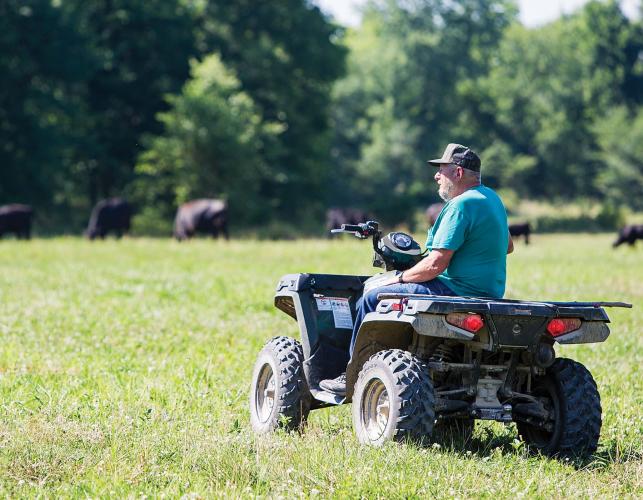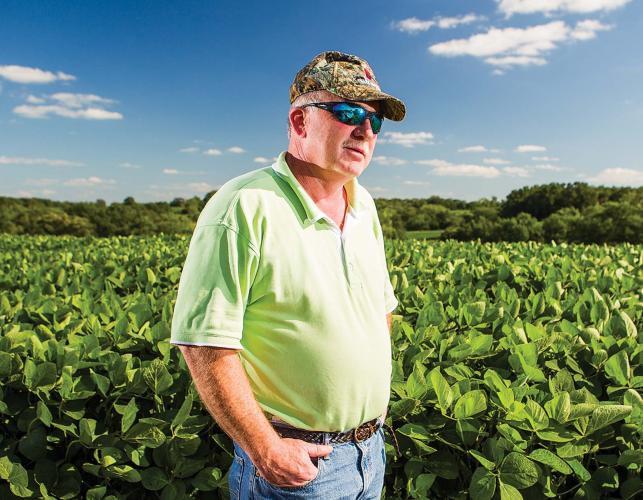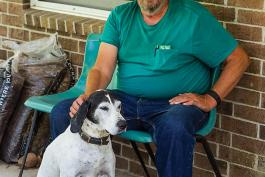Morris Ratliff sits on his front porch with his dog Mitch. He just finished his day bailing hay. Ratliff owns 360 acres of land in Macon County. He leases 85 acres to a neighbor, but the rest he farms and lets his 35 head of cattle graze. He’s owned this property since 1995, and he enjoys the beauty of the landscape and the abundant white-tailed deer.
Standing on a ridgetop, overlooking his bean fields, Vernon Robertson pauses and points out that his fields run as far as the eye can see and then some. Robertson purchased his 212 acres nine years ago. He’s a hunter, he emphasizes, and has been his entire life.
When both men bought their property in north-central Missouri, neither would have imagined their land would be smack in the middle of an outbreak of chronic wasting disease (CWD). Both have had a deer test positive for the disease since it was first detected in Missouri in 2010. And both have made sacrifices to help the Missouri Department of Conservation control this disease and keep it from spreading.
Too Close for Comfort
Macon County consistently ranks in the top five for total deer harvest in Missouri. The area is known for its abundant deer. This knowledge was not lost on Vernon Robertson. He bought his land for the “big bucks.”
“I’ve been a deer hunter ever since I can remember, since I was a little guy,” Robertson says. “I’ve got crops, but the big buck situation; there are a lot of state records coming out of here. That’s the reason I bought it, to hunt.”
But those record-breaking deer haven’t been around much the past three years.
When chronic wasting disease was first detected in Missouri, it was a co-worker of Robertson’s who brought it to his attention. Because of the proximity of the find to his land, he realized he was going to have to take a closer look at the disease.
“When I learned the case was found probably about a mile from here, I thought to myself that this could be serious.”
When Morris Ratliff retired from military and civil service in 1997, he knew he needed something to do. Being familiar with north-central Missouri, and with relatives nearby, he decided to purchase land in Macon County two years earlier.
Ratliff enjoys letting his friends and family members hunt deer on his property. According to Ratliff, his land is just perfect for the animal.
“If you look around this property, we are ideally situated for deer and other wildlife. We have Mussel Fork Creek that runs down in the middle for about half a mile, you have pastured and crop ground, lots of trees, the deer just thrive here.”
But three years ago, that began to change. That’s when chronic wasting disease was detected in captive deer at a private big-game hunting preserve located next to Ratliff’s property.
Before chronic wasting disease was found, he had never heard of the disease. In fact, Ratliff really didn’t pay too much attention when his good friend, the manager of the wildlife ranch adjacent to his property, called to tell him it was detected at the facility.
“I didn’t really have a reaction when it was first found,” Ratliff says. “But when it was later found in Macon County near my property, I thought, wow, it’s pretty close.”
Taking Stock of an Outbreak
Over the coming weeks and months, Ratliff, Robertson, and numerous other landowners around the CWD-positive captive facility would be asked to help the Department of Conservation test additional deer to determine the prevalence, distribution, and severity of the disease outbreak in the area. This included targeted culling of free-ranging deer.
Chronic wasting disease is a fatal brain disease of the cervid family. It is spread primarily through deer-to-deer contact. It can also be spread over several miles when young bucks leave an area in search of territory and mates.
In 2012, the Conservation Department developed a chronic wasting disease management plan for the CWD Containment Zone (a six-county area that includes Adair, Chariton, Linn, Macon, Randolph, and Sullivan) that called for great local landowner sacrifice to protect the long-term health of Missouri’s deer herd.
This plan included the removal of the extremely popular 4-point rule (antler restriction), and it enacted a ban on the placement of feed, salt, and other minerals intended to attract and concentrate deer. The most significant provision of the plan was a call to increase harvest during the hunting season and additional targeted culling following the hunting season within the CWD Core Area, a 30-square-mile area that surrounds the Linn-Macon county line where CWD-positive deer have been found.
The challenge with chronic wasting disease is that there is no known management strategy that can effectively eradicate CWD from a population once it has become established.
However, removing infected or potentially infected deer from the population early in an outbreak offers some hope of limiting the spread of chronic wasting disease. In addition, the Department has held 23 public deer meetings in the last year and a half to listen to Missouri citizens.
For the past three years, landowners such as Ratliff and Robertson have been working alongside the Conservation Department to lower deer numbers and test as many deer as possible within the CWD Core Area.
Making Sacrifices
Robertson decided he would do his part in helping the Department manage for chronic wasting disease, based in part on the Department’s past restoration efforts of this prized game animal.
“I look back when there weren’t any deer. It was the Conservation Department that brought them in here. When you get right down to it, it was their measures that brought them in here the way they are.”
It’s that belief, that confidence due to past successes, that reassures Robertson in his work with the Department.
“It’s a challenge, but if we can keep chronic wasting disease
in this area and continue to do that, regardless if we don’t ever get rid of it, if we can keep it here, then I think that is the best for everybody.”
Robertson recognizes that when working with chronic wasting disease, it’s a long road. But he remains optimistic and ready to help and do his part.
“If I can take care of my own little world, that’s about all any of us can do. I’d rather work with it and set the example for the people around me and continue to cooperate.
It’s a state issue, and because I choose to live in Missouri, it’s my issue too.”
And while the hunting is still there, it’s not the same for Robertson and his clan as it was a couple of years ago. The increased pressure on the deer population is evident. But, that hasn’t prevented his friends and family from gathering each year on his property for their annual deer camp.
“They know I’m dealing with chronic wasting disease, but they still look forward to coming here every year for deer season. It’s not the population that we had, but they still come up; it is a social event. We’ve got a history of many, many decades of deer hunting. It’s part of our family culture.”
Differing Opinions
Since 2011, Ratliff has had approximately 55 deer harvested from his property. His cooperation with the Conservation Department has sometimes caused differing opinions with his neighbors, some of which are relatives.
“Some people complain that I’m letting the Conservation Department kill all the deer [on my property]. I get a lot of little jabs. But I feel that the problem was identified, and you might as well get on with it and deal with the issue.”
Since then, Ratliff says he and his neighbors have just agreed to disagree on the efforts to remove deer. He remains optimistic for the future of the deer on his land.
“I think we are going to get chronic wasting disease under control. The most important thing, in my opinion, is I think we have been making progress, we are headed in the right direction.”
Dedicated Stewards Make a Difference
While neither man looks at his individual efforts as a sacrifice, their cooperation along with the dozens of other cooperating landowners in the CWD Containment Zone in working hand-in-hand with the Conservation Department to protect and conserve one of the state’s most valuable natural resources has been crucial in the efforts to limit the spread of chronic wasting disease. It is only through the commitment of dedicated stewards of the land that conservation efforts can be successful.
For Robertson, the fight is personal. With a 14-year-old daughter and a 16-year-old son who enjoy hunting, he wants to leave his children with a place they can always come to and enjoy the hunting heritage he is passing down to them.
“I told my kids, don’t sell this property because of chronic wasting disease. Regardless of what happens with CWD, it’s still land. You can still have crops, squirrel hunt, rabbit hunt. Dealing with the disease, we’ll just deal with it.”
Results of the 2013 CWD Surveillance Effort
The sacrifices being made by these grass-roots conservationists may be improving the outlook in their area. A total of 3,666 deer were tested statewide for chronic wasting disease (CWD) during and after the 2013 deer hunting seasons, including more than 200 deer in the CWD Core
Area, and all tests came back negative.
“While we are cautiously optimistic that these latest test results suggest our efforts to limit the spread of chronic wasting disease may be working, the threat of this infectious disease remains significant,” says MDC State Wildlife Veterinarian Kelly Straka. “Therefore, continued surveillance is important.”
This large-scale testing effort was made possible through the cooperation of many of the state’s hunters, landowners, and taxidermists — proving once again that Missourians care about conserving forests, fish, and wildlife. Although the absence of any positive CWD tests is encouraging, that doesn’t mean this disease has been successfully eliminated from the state’s deer population.
“More than 90 percent of Missouri land is privately owned, so landowners are vital to deer management and to our ongoing efforts to limit the spread of chronic wasting disease,” Dr. Straka says. “We greatly appreciate the cooperation of local landowners in the CWD Core Area who participated in this effort. Their sacrifice in temporarily reducing local deer numbers is helping to protect the health of deer throughout the state.”
The Conservation Department continues to work with hunters, landowners, businesses, other agencies, and partner organizations to identify the disease and limit the spread of chronic wasting disease in Missouri. Anyone seeing sick deer are encouraged to call their local conservation agent or office.








And More...
This Issue's Staff
Managing Editor - vacant
Art Director - Cliff White
Staff Writer/Editor - Brett Dufur
Staff Writer - Jim Low
Photographer - Noppadol Paothong
Photographer - David Stonner
Designer - Stephanie Thurber
Circulation - Laura Scheuler






















